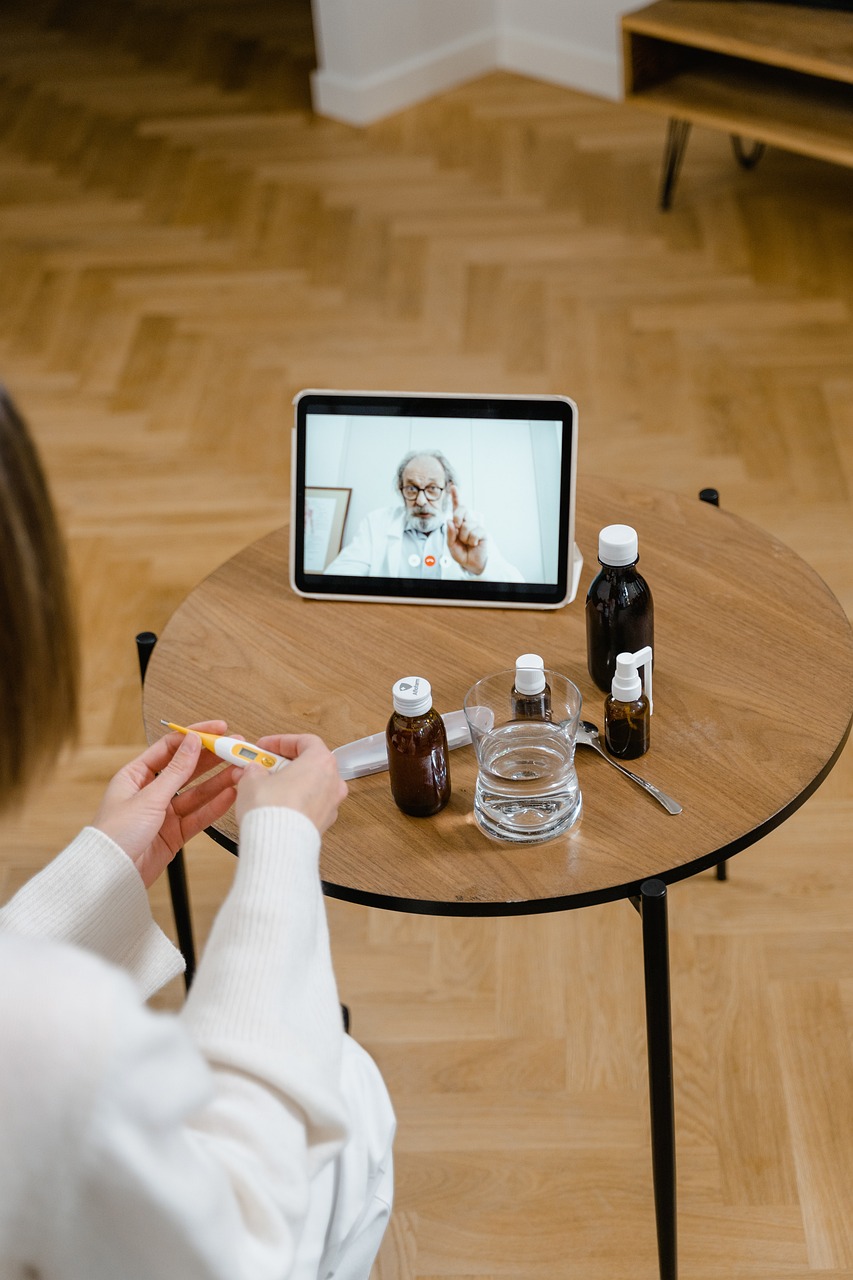Imagine a world where seniors can easily access high-quality healthcare from the comfort of their own homes. Thanks to the rapid advancements in technology, this vision is becoming a reality. Telemedicine, a form of remote healthcare, is reshaping the way senior healthcare is delivered. Gone are the days of long commutes and endless waiting rooms. With just a few clicks, seniors can connect with healthcare professionals, receive medical advice, and even have virtual consultations. As we delve into the impact of telemedicine on senior healthcare, it becomes evident that this emerging technology is revolutionizing the way we care for our elderly population. From virtual check-ups to robotic assistance, telemedicine is bringing convenience, accessibility, and peace of mind to seniors across the globe.
The Benefits of Telemedicine for Seniors
Improved access to healthcare
Telemedicine offers seniors improved access to healthcare services by eliminating the barriers of distance and mobility. With telemedicine, seniors can easily connect with healthcare providers through virtual consultations, regardless of their physical location. This convenience allows seniors living in remote areas or those with limited access to transportation to receive timely medical care.
Convenience and reduced travel
One of the biggest advantages of telemedicine for seniors is the convenience it offers. Instead of having to travel to a healthcare facility for routine check-ups or follow-up visits, seniors can consult with their healthcare providers from the comfort of their own homes. This not only saves time and energy but also reduces the burden of travel, especially for seniors with mobility issues or chronic conditions.
Enhanced coordination of care
Telemedicine enables better coordination of care among healthcare professionals involved in a senior’s treatment. Through virtual consultations, caregivers, primary care physicians, specialists, and other healthcare providers can easily communicate, exchange medical information, and collaborate on the best treatment plans for seniors. This seamless coordination ensures that all parties are aligned and working together to provide comprehensive and effective care.
Reduction in healthcare costs
Telemedicine has the potential to reduce healthcare costs for seniors. By eliminating the need for frequent hospital visits and reducing unnecessary emergency room visits, telemedicine can lead to significant cost savings. Additionally, remote consultations and monitoring can help prevent complications and detect health issues at an early stage, leading to more efficient and cost-effective management of chronic conditions.
Challenges and Limitations of Telemedicine in Senior Healthcare
Technology barriers
One of the major challenges in implementing telemedicine for seniors is the technology barrier. Many seniors may not be familiar with using digital devices or may lack access to reliable internet connections. Overcoming these barriers may require additional support and education to help seniors become comfortable with using telemedicine platforms and devices.
Lack of familiarity and digital literacy
Related to technology barriers, lack of familiarity and digital literacy can also hinder the widespread adoption of telemedicine among seniors. Older adults who are not accustomed to using computers or smartphones may find it challenging to navigate telemedicine platforms or communicate effectively during virtual consultations. Providing user-friendly interfaces and offering training sessions can help bridge this gap.
Physical limitations and disabilities
Telemedicine may not be suitable for seniors with severe physical limitations or disabilities. For example, seniors with visual impairments or motor disabilities may struggle with operating telemedicine devices or participating in virtual consultations. Accommodations and adaptations must be made to ensure that telemedicine is accessible to seniors with different physical abilities.
Privacy and security concerns
As with any technology-based service, privacy and security concerns exist with telemedicine. Seniors may worry about the confidentiality of their medical information and the security of their personal data. It is crucial for healthcare providers and telemedicine platforms to implement robust privacy measures and ensure that seniors’ confidential information is protected.

This image is property of pixabay.com.
Telemedicine Applications in Senior Healthcare
Remote consultations and diagnosis
Telemedicine enables seniors to have remote consultations and receive timely diagnosis from healthcare professionals without physically visiting a clinic or hospital. This is particularly beneficial for seniors who have difficulty traveling or those who live in remote areas without easy access to healthcare facilities. By leveraging video conferencing and other digital communication tools, healthcare providers can assess patients, discuss symptoms, and provide appropriate treatment plans.
Medication management
Telemedicine can improve medication management for seniors by providing remote medication reviews, refill requests, and reminders. Through virtual consultations, healthcare providers can assess medication regimens, ensure adherence, and address any concerns or side effects. This helps seniors avoid medication errors, better understand their prescriptions, and stay on track with their treatment plans.
Telemonitoring and chronic disease management
For seniors with chronic diseases such as diabetes, heart conditions, or respiratory illnesses, telemedicine offers the ability to remotely monitor their health status. Through wearable devices and digital health apps, vital signs, such as blood pressure, heart rate, or blood glucose levels, can be measured and transmitted to healthcare providers for real-time monitoring and analysis. This proactive approach allows for early intervention and personalized care plans to manage chronic conditions effectively.
Mental health support
Telemedicine plays a crucial role in providing mental health support for seniors. Virtual therapy sessions, counseling, and psychiatric consultations can be conducted to address issues such as anxiety, depression, loneliness, or grief. Telemedicine eliminates the barriers of transportation and stigma associated with seeking help, making mental health services more accessible and convenient for seniors.
Rehabilitation and physical therapy
Seniors recovering from surgeries, injuries, or stroke can benefit from telemedicine-enabled rehabilitation and physical therapy. Through virtual sessions, therapists can assess range of motion, provide exercise instructions, and guide seniors through personalized rehabilitation programs. This not only allows seniors to receive therapy from the comfort of their homes but also ensures continuity of care even after being discharged from hospitals.
Preventive care and health education
Telemedicine can promote preventive care and health education among seniors. Regular check-ups, health screenings, and health education sessions can be conducted remotely, helping seniors stay informed about their health and wellness. Telemedicine can facilitate easy access to preventive services, such as vaccinations, cancer screenings, and lifestyle counseling, thus promoting proactive healthcare management.
Telemedicine Adoption among Seniors: Current Trends and Statistics
Increasing utilization rates
The adoption of telemedicine among seniors has been steadily increasing in recent years. According to a study published in the Journal of the American Medical Association, telemedicine utilization rates among Medicare beneficiaries surged by nearly 46% from 2019 to 2020. This upward trend reflects the growing acceptance and recognition of telemedicine as a valuable tool in senior healthcare.
Factors influencing adoption
Several factors contribute to the increasing adoption of telemedicine among seniors. The convenience and accessibility offered by telemedicine, especially for those with limited mobility or living in remote areas, are key drivers of adoption. Additionally, the COVID-19 pandemic has accelerated the adoption of telemedicine as seniors sought ways to receive healthcare without risking exposure to the virus.
Age, gender, and socioeconomic disparities
While telemedicine adoption rates are increasing, there are still age, gender, and socioeconomic disparities to address. Older seniors, women, and those from lower-income households may face more challenges in adopting telemedicine due to limited technology access, digital literacy, or financial constraints. Working towards bridging these disparities is crucial to ensure equal access to telemedicine for all seniors.
Barriers to widespread adoption
Despite the growing adoption, barriers to widespread telemedicine adoption among seniors still exist. As previously mentioned, technology barriers, lack of digital literacy, physical limitations, and privacy concerns continue to pose challenges. Addressing these barriers requires collaboration among healthcare providers, policymakers, technology companies, and community organizations to provide tailored support and education for seniors.

This image is property of pixabay.com.
Telemedicine and Aging-in-Place
Enabling independent living
Telemedicine plays a significant role in enabling seniors to age in place independently. With remote healthcare services, seniors can receive necessary medical attention, monitoring, and support while remaining in their own homes. This reduces the need for institutional care and empowers seniors to maintain their desired level of independence and quality of life.
Home-based healthcare services
Telemedicine supports the delivery of home-based healthcare services for seniors. Skilled professionals, such as nurses, therapists, or caregivers, can remotely assess seniors’ health status, provide guidance on self-care, and monitor their progress. This home-based approach reduces the need for seniors to visit hospitals or healthcare facilities regularly, allowing them to receive personalized care in the comfort of their homes.
Remote monitoring and emergency response
Telemedicine enables remote monitoring of seniors’ health, especially for those with chronic diseases or mobility issues. Sensors, wearable devices, or smart home technologies can collect data on vital signs, falls, or emergencies, which can trigger timely responses from healthcare professionals or emergency services. This continuous monitoring provides peace of mind for seniors and their loved ones, knowing that help can be quickly summoned if needed.
Addressing social isolation
Social isolation is a significant concern for seniors, especially those living alone or with limited social connections. Telemedicine offers a solution by providing regular virtual interactions with healthcare providers, therapists, or support groups. These virtual interactions not only address medical needs but also provide an opportunity for seniors to engage socially and combat feelings of loneliness and isolation.
Telemedicine and Preventive Care for Seniors
Promoting regular check-ups
Telemedicine encourages seniors to prioritize regular check-ups and preventive care. Through virtual consultations, healthcare providers can assess general health, screen for risk factors, and detect early signs of potential health issues. By emphasizing preventive care, telemedicine helps seniors maintain their well-being and avoid potential complications or hospitalizations.
Screenings and early detection
Telemedicine facilitates screenings and early detection of various diseases and conditions. Seniors can undergo virtual screenings for conditions such as cancer, cardiovascular diseases, osteoporosis, or cognitive decline. Early detection allows for timely interventions and personalized treatment plans, improving health outcomes and reducing the burden of disease for seniors.
Healthy lifestyle management
Telemedicine offers seniors support in managing healthy lifestyles. Through virtual sessions, healthcare providers can offer guidance on diet, exercise, stress management, and other lifestyle factors. This personalized approach promotes healthy behaviors and empowers seniors to take an active role in their own health and well-being.
Immunizations and vaccinations
Telemedicine promotes the administration of immunizations and vaccinations among seniors. Healthcare providers can remotely assess seniors’ immunization status, recommend necessary vaccines, and provide guidance on their administration. By ensuring seniors receive the recommended immunizations, telemedicine helps protect them from vaccine-preventable diseases and reduces the risk of complications.

This image is property of pixabay.com.
Telemedicine and Chronic Disease Management in Seniors
Improving access to specialists
Telemedicine bridges the gap in accessing specialized healthcare professionals for seniors with chronic diseases. Through virtual consultations, seniors can consult with specialists such as cardiologists, endocrinologists, or neurologists without the need for extensive travel or waiting times. This timely access to specialists ensures comprehensive and focused management of chronic conditions.
Real-time monitoring and data analysis
Telemedicine enables real-time monitoring and analysis of seniors’ health data. Through wearable devices, such as smartwatches or connected glucometers, vital signs or disease-specific indicators can be tracked and shared with healthcare providers. This data-driven approach allows for more precise management of chronic conditions, timely interventions, and optimization of treatment plans.
Personalized care plans
Telemedicine supports the development and implementation of personalized care plans for seniors with chronic diseases. By remotely monitoring seniors’ health status, healthcare providers can tailor treatment plans according to individual needs and responses. This personalized approach ensures that seniors receive the most effective interventions and ongoing support to manage their chronic conditions.
Reducing hospital readmissions
Telemedicine plays a critical role in preventing hospital readmissions among seniors with chronic diseases. By closely monitoring seniors’ health remotely, healthcare providers can identify early warning signs, initiate timely interventions, and provide medical guidance to prevent exacerbations or complications. This proactive approach reduces the need for emergency room visits or hospital readmissions, promoting effective chronic disease management and improving seniors’ overall quality of life.
Telemedicine and Mental Health Support for Seniors
Overcoming barriers to seeking help
Telemedicine helps overcome barriers to seeking mental health support among seniors. Many older adults may feel reluctant or stigmatized when seeking help for mental health concerns. With telemedicine, seniors can access virtual therapy sessions or counseling from the comfort and privacy of their own homes, eliminating the need to travel or visit unfamiliar clinics.
Remote therapy and counseling
Telemedicine provides seniors with access to remote therapy and counseling services. Virtual sessions can be conducted via video calls or phone consultations, allowing seniors to connect with mental health professionals without leaving their homes. Remote therapy offers convenient and flexible scheduling, making it easier for seniors to incorporate mental health support into their lives.
Supporting cognitive health
Telemedicine plays a crucial role in supporting seniors’ cognitive health. Through virtual consultations, healthcare providers can assess cognitive function, provide cognitive stimulation exercises, and offer guidance on managing age-related memory loss or cognitive decline. Telemedicine can also facilitate care coordination among interdisciplinary teams, including geriatric specialists and neuropsychologists, in diagnosing and managing cognitive disorders.
Access to specialized geriatric mental healthcare
Telemedicine expands access to specialized geriatric mental healthcare for seniors. Geriatric psychiatrists and psychologists who specialize in the unique mental health needs of older adults may be in limited supply. Telemedicine allows seniors to receive virtual consultations and therapy sessions with these specialized providers, ensuring the delivery of appropriate and individualized mental health care.
The Role of Telemedicine in Caregiver Support for Seniors
Remote training and education
Telemedicine supports remote training and education for caregivers of seniors. Caregivers can receive virtual training sessions on caregiving techniques, disease management, and emergency response. Telemedicine also facilitates ongoing education and updates for caregivers, ensuring they have the necessary knowledge and skills to provide optimal care for seniors.
Care coordination and communication
Telemedicine enhances care coordination and communication among healthcare professionals and family caregivers. Through virtual conferences or messaging systems, healthcare providers and caregivers can collaborate, exchange information, and discuss care plans. This seamless communication ensures that all parties involved in a senior’s care are informed and involved in decision-making.
Supporting family caregivers
Telemedicine provides valuable support to family caregivers by offering virtual consultations and guidance on caregiving challenges. Family caregivers can remotely consult with healthcare professionals, ask questions, and seek advice on managing specific conditions or situations. Telemedicine empowers family caregivers to make informed decisions and provides reassurance that they are not alone in their caregiving journey.
Reducing caregiver burnout
Telemedicine plays a significant role in reducing caregiver burnout by providing remote support and respite options. Through virtual consultations or telecare services, caregivers can access counseling, therapy, or support groups specifically designed to address caregiver stress and burnout. This support ensures caregivers’ mental and emotional well-being, thus enhancing their ability to provide high-quality care for seniors.
Future Directions and Opportunities for Telemedicine in Senior Healthcare
Advances in telehealth technology
Advances in telehealth technology hold immense potential for expanding and improving senior healthcare in the future. Innovations such as remote monitoring devices, artificial intelligence (AI)-enabled diagnostic tools, and virtual reality-based therapies are emerging as transformative solutions. These technological advancements will enhance the capabilities and effectiveness of telemedicine in addressing the unique healthcare needs of seniors.
Integration of artificial intelligence
The integration of artificial intelligence (AI) in telemedicine has the potential to revolutionize senior healthcare. AI algorithms can analyze vast amounts of health data, identify patterns, and provide personalized insights and recommendations for seniors’ care. AI-driven chatbots or virtual assistants can also offer 24/7 support, answering questions and providing basic medical information to seniors.
Wearable devices and remote monitoring
Wearable devices and remote monitoring technology will continue to play a crucial role in telemedicine for seniors. These devices can track vital signs, activity levels, sleep patterns, and even falls, providing real-time data to healthcare providers for remote monitoring. The integration of such devices with telemedicine platforms ensures comprehensive care and enables early intervention in case of emergencies or changes in seniors’ health status.
Telemedicine policy and reimbursement
As telemedicine continues to evolve, policymakers and healthcare systems must adapt policy frameworks and reimbursement models to support its integration into senior healthcare. Regulatory changes that ensure reimbursement for telemedicine services, expand telehealth coverage, and address privacy concerns will be crucial in fostering the widespread adoption and sustainability of telemedicine in senior healthcare.
In conclusion, telemedicine holds immense promise in transforming senior healthcare. With improved access, convenience, and coordination, telemedicine offers numerous benefits for seniors, including enhanced preventive care, chronic disease management, mental health support, and caregiver support. While challenges and barriers exist, the increasing adoption and evolving technology present great opportunities for telemedicine to support seniors in aging gracefully, maintaining their independence, and improving their quality of life. With ongoing advancements in telehealth technology and policy changes, the future of telemedicine in senior healthcare looks promising, paving the way for more effective and personalized care for the aging population.


